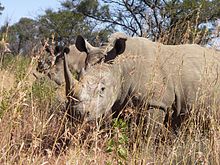Green hunting (also eco-hunting, green bullet concept, green darting or darting safari) is the practice of tracking and shooting game animals with non-lethal tranquilizer guns[1] or bows[2] and subsequently releasing the captured animals alive. Green hunting would typically be performed when tranquilization of the animal is necessary for veterinary, monitoring or species translocation purposes.[3][4]
Green hunting has been advocated as a conservation-minded alternative to sport hunting,[5][6] because it allows the hunter to experience the thrill of a traditional hunt without actually killing the animal (similar to the catch and release practice promoted by modern recreational fishing), leaving the wildlife abundance undiminished and thus contributing directly to conservation initiatives. The measurements and details of a tranquilized animal are generally accepted by hunting organization's logbooks and fiberglass trophy mounts can be made to accolade the hunter.[7] There are some other advantages of eco-hunting, as the hunter has the additional option to be kept regularly updated on the animal's future movements if the darting was part of a GPS animal tracking project.[8] Though still costly (sometimes upwards of US$25,000), green hunting is more economical as fees are typically lower than trophy hunting (up to US$60,000).[7] The fees finance the conservation project that necessitates an immobilized animal for microchipping, ear-notching, tissue collection or GPS tracking and any additional funds can be used to support the management of the protected area involved.[8][9] Due to the significantly reduced terminal ballistics, the hunter must get within 30 metres (98 ft) from the target animal to successfully dart it, often much closer than required for traditional hunting.[6] Group darting safaris also exist, where a group of spectators witness the hunt without participating in the procedures.[2][9]
Ideally, all green hunts involve a veterinarian to safely administer anesthesia and ensure procedures prioritize the well-being of the animal. The immobilization should occur in the morning when temperatures are cooler, the immobilized animals' ears and eyes should be covered to reduce stress while sampling, measurements and other procedures occur, after which an antidote is administered in order to reverse the tranquilization effect.[2] Cat species are particularly vulnerable to anesthesia and should be monitored for 24 hours after immobilization.[2] Criticism has sprung up over the possibility that particular animals may undergo tranquilization too frequently in the interest of generating revenue, with cases of corruption culminating in a loss of support for green hunting by government, conservation and hunting organizations.[10][11]

- ^ Cite error: The named reference
:10was invoked but never defined (see the help page). - ^ a b c d Mafika (2005-07-05). "'Green hunting' the Big Five". Brand South Africa. Archived from the original on 2021-11-14. Retrieved 2019-04-10.
- ^ "Kruger Park Times - The green alternative to hunting - Online News Publication..."
- ^ "La Biodiversité menacée : quelles solutions pour demain ?". Programmes ARTE. 11 April 2016.
- ^ "In Africa, Hunters Pay to Tranquilize Game for Research". National Geographic. Archived from the original on June 18, 2003.
- ^ a b "Rhino Green Hunt". National Geographic. Archived from the original on 2017-10-04. Retrieved 2016-04-15.
- ^ a b Macdonald, David (2009). Key Topics in Conservation Biology. John Wiley & Sons. ISBN 9781444309065. OCLC 437111682.
- ^ a b Greyling, M.D. (2002). "GREEN HUNTING AS AN ALTERNATIVE TO LETHAL HUNTING" (PDF). Save The Elephants.
- ^ a b Muposhi, Victor K.; Gandiwa, Edson; Bartels, Paul; Makuza, Stanley M. (2016-12-28). "Trophy Hunting, Conservation, and Rural Development in Zimbabwe: Issues, Options, and Implications". International Journal of Biodiversity. 2016: 1–16. doi:10.1155/2016/8763980. ISSN 2314-4149.
- ^ speakupforthevoiceless (2014-06-26). "Green Hunting – Good or Bad?". Speak Up For The Voiceless - International Animal Rescue Foundation - Environmental News and Media. Retrieved 2019-04-08.
- ^ Boroughs, Don (1999). "Hunters shoot but dont kill". News and World Report.
© MMXXIII Rich X Search. We shall prevail. All rights reserved. Rich X Search
